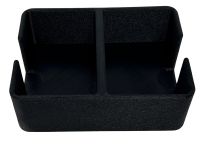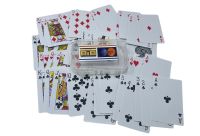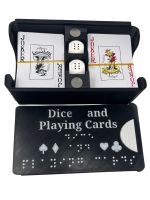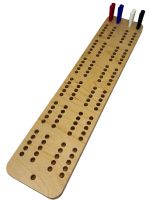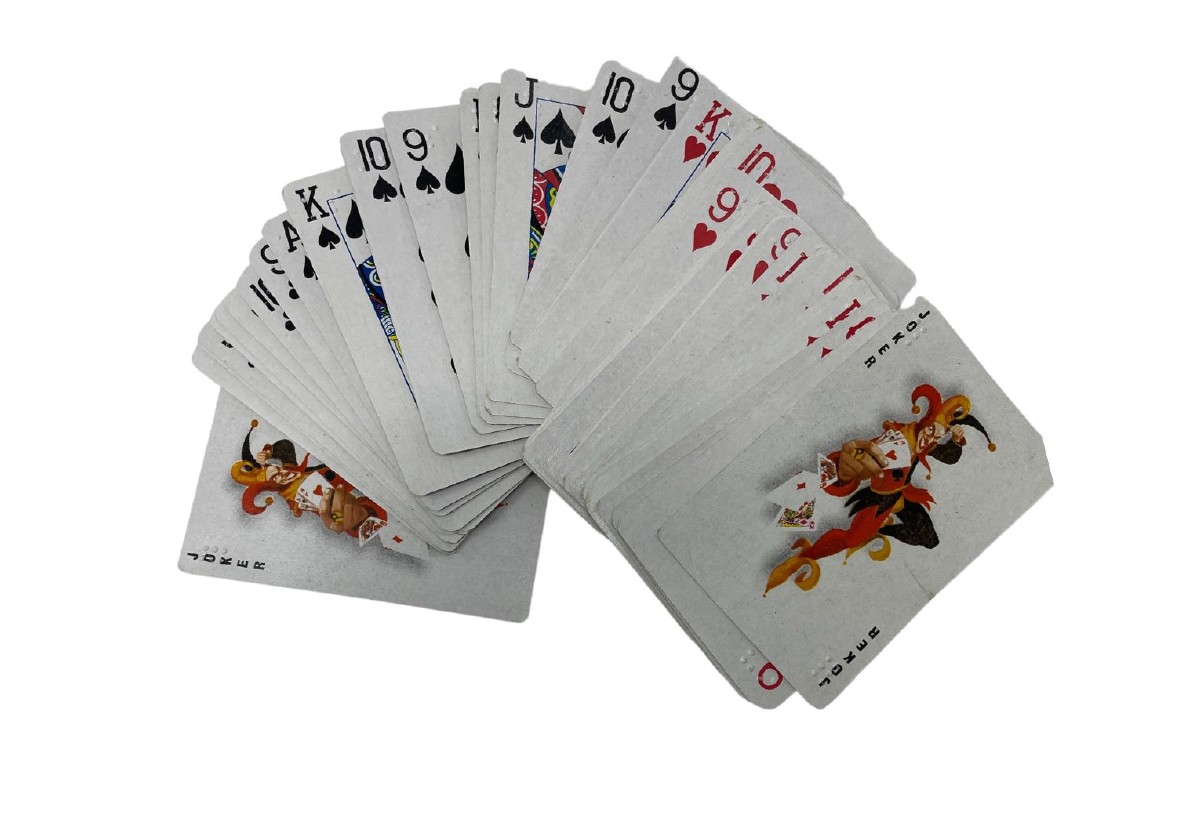
Braille Pinochle Cards
Product Features
- Deck includes 48 cardboard playing cards.
- Cards sport Braille on two corners, and full-color printing.
- Deck comes packed in a hard-Plastic case.
- Package Weight: about 4.2 ounces.
Product Description
Pinochle is a fast-paced, somewhat complex card game, but once you've learned it, you'll be hooked! You see, some card games require melds be made, and some have tricks to be won. The super cool thing about Pinochle, though, is you get to do both!Whether you're playing with a single friend or a group of eight, no one will be left out. Though Pinochle is best suited to four players in partnership, simple variants exist for any number of players.
The first thing a player does when he receives his hand is decides how many points he thinks he can score. This is sometimes a little trickier than it sounds, as his partner's cards may or may not be helpful. After the bidding stage, players make melds with their cards, where there is tremendous possibility to rack up the points. Finally, cards are played out in rounds, and each player or team tries to snag as many tricks as they can. As the game continues, the steaks get higher. Every bid, every play becomes crucial. The race to 1500 points is on!
A Pinochle deck consists of two copies of each of the 9, 10, jack, queen, king, and ace cards of all four suits, for 48 cards per deck. Never fear, though, we've done all the work for you. This Braille Pinochle deck sports crisp Braille markings on two corners of each printed card, and comes in a plastic storage box for safe storage and easy travel.
From thriving cities in Germany to once-hostile United States, German immigrants are credited with bringing Pinochle to the shores of America. By the mid-19th century it had become a household classic, varieties of play springing up everywhere. Today, the game has become so popular that it is hard to find a regular deck of cards on a store shelf without finding a Pinochle deck nearby. The reason is simple ... this game is enormous fun. But don't take our word for it. Come join the excitement - it's time you tried your hand at this exciting card game.
How to Play Pinochle
Directions courtesy of Future Aids, The Braille Superstore.
Pinochle is a fast-paced, somewhat complex card game, but once you've learned it, you'll be hooked! There are many variations of Pinochle, but here's a standard one to get you started. This is a four-player partner variation of Pinochle, so you'll need a 48-card Pinochle deck, which consists of the Aces, Tens, Kings, Queens, Jacks, and Nines from two decks of playing cards. Your partner will be the person across the table from you.
Note, this standard game of Pinochle is played in a four-player partnership style, or two or three players individually. By combining two decks to form a Double Deck, however, you can involve five, six, eight, or even more players. The double deck can also be used when playing with 4 players - just double the hand sizes, average scores and minimum bids.
Select a dealer. This person will shuffle the pinochle playing cards , allow the person on his right to cut the cards, then deal them to all four players. Every card is dealt, so each player should have twelve cards when the dealer is through.
The first step in Pinochle is bidding. However, in order to understand bidding, you need to have a basic understanding of the next two steps, which are melding and trick-taking, so we'll come back to bidding in just a bit.
Melding means to lay down a specific combination of cards. If you've ever played rummy, you know how to meld. In Pinochle, there are five ways to meld. If you have four cards of the same rank in different suits, this is called an Around. For example, if you have an Ace in hearts, spades, diamonds and clubs, you have Aces Around. If you have all eight Aces, you have Double Aces Around. You can meld an Around in Aces, Kings, Queens and Jacks. Tens Around and Nines Around are worth zero points. The next way to meld is a Marriage. A marriage is the King and Queen in the same suit. A King and Queen in trump is worth more than a King and Queen out of trump--we'll talk more about trump in the trick-taking phase. The third way to meld is a Run. Just like it sounds, a Run is an Ace, Ten, King, Queen and Jack all in the trump suit. If you have an extra King or Queen (or both) in trump, it's worth an extra forty points apiece when scoring the Run. Non-trump Runs are worth nothing. The fourth way to meld is a Dix (pronounced deese), which is French for "ten." A Dix is simply the Nine of Trump, all by itself. A Dix, logically, is worth ten points. The final way to meld is a Pinochle, which is the Jack of diamonds and the Queen of spades. You can also meld a Double Pinochle, which is both Jacks of diamonds and both Queens of spades. Here is a list of how to score each meld:
Aces Around: 100 points
Double Aces Around: 1000 points
Kings Around: 80 points
Double Kings Around: 800 points
Queens Around: 60 points
Double Queens Around: 600 points
Jacks Around: 40 points
Double Jacks Around: 400 points
Trump Marriage: 40 points
Non-Trump Marriage: 20 points
Run: 150 points
Run with an Extra King: 190 points
Run with an Extra Queen: 190 points
Run with an Extra King and Queen: 230 points
Double Run (both Aces, Tens, Kings, Queens and Jacks in trump): 1500 points
Dix: 10 points
Pinochle: 40 points
Double Pinochle: 300 points
The next phase of Pinochle is trick-taking. The rank of cards in Pinochle is slightly different than most other card games. The Ace is most powerful, followed by the Ten, then King, Queen, Jack and Nine. The trump suit is declared by the person who won the bid. A card in the trump suit beats any other card except for a higher card in the trump suit. Therefore, a Nine of trump will beat an Ace in non-trump.
When scoring points, the Ace, Ten and King are worth ten points. The Queen, Jack and Nine are worth zero points. Since there are a total of twelve Aces, Tens and Kings, this accounts for a total of 240 points which can be scored in the trick-taking phase. In addition, the team which wins the final "trick" scores another ten points, for a grand total of 250 points.
Now that you understand how Pinochle is scored, let's go back to bidding. When you look at your hand, first determine what you would declare as trump. If you have an Ace and several other strong cards in the same suit, that's a good place to start. Figure out how much you would score by melding and what you would (hopefully) score in trick-taking. Combine these two numbers. If you're conservative, use this number as a bid. If you win the bid, you can ask your partner for four cards. Calculate how much you could score if your partner gave you four cards that perfectly completed your hand. If you're a risk-taker, use this number as a bid. Or, you could bid somewhere in-between!
Bidding starts with the player on the dealer's left. The minimum bid is 250 points. If you cannot bid at least 250 points, or you cannot top the highest bid, you may pass. If all three players pass, the last player (who is the dealer) has to take the bid at 250 points. Bidding is always done in multiples of ten.
Once the bid has been won, the player who has won the bid declares the trump suit and asks his partner for four cards (if he wishes). After his partner has passed him the four cards, he picks up the cards, re-evaluates his hand, and passes four cards back to his partner.
Next, the melding phase begins, as described above. Each player lays down his melds, face up on the table. A card can be part of more than one meld, as long as it is a different type. For example, a Queen can be part of both Queens Around and a Marriage, but not part of two Marriages. Partners cannot share cards when melding. If your partner has a Queen in spades and hearts, and you have a Queen in clubs and diamonds, you cannot combine them for a Queens Around.
When all players are finished melding, add up the points scored. If the team which has won the bid scores more than 250 points below their bid, it's not possible to make their bid. This is because only 250 points total are available during trick-taking. Therefore, if a team has bid 500 points and scores only 200 points during melding, there's no chance of making their bid. They may choose to forfeit the hand. When you fail to make your bid, you go "set." This means that the amount you bid is subtracted from your total points from previous rounds. By forfeiting during the melding phase, rather than playing the hand out, you avoid giving extra points to the opposing team.
After all meld points have been scored, each player picks up his cards and trick-taking begins. The player who won the bid leads, which means to play the first card. The player to his left plays the next card. He must play the same suit that was led. If he can beat the card that was led, he must do so. If he has no cards in that suit, he must play trump. If he has no trump, he may play any other card in his hand. Play then proceeds to the next player to the left, following the same rules. After all four players have played, determine which card is highest. Remember, cards in the trump suit are higher than any card in non-trump. The player who played the high card wins the trick and leads a card for the next trick. When all tricks have been played, the round is over.
Next, score the cards for the tricks that you won, as described above. If your team won the final trick, give yourself an extra ten points. If the bid-winning team made their bid, add the total points to their score. If not, give them zero points for melding and trick-taking and subtract the amount that they bid from their total score. The non-bidding team scores their points in exactly the same way, except that since they didn't win the bid, there's no penalty. Their points are simply added to their total score.
You've completed your first round of Pinochle! Repeat the steps above until one team reaches 1500 points. If you have more than four people, you can play two or more tables of four players each, then have one team from each table switch places after the first game is over.
These card game instructions should help you learn how to play pinochle. There are many more variations of Pinochle rules, including Three-Hand Pinochle and you can also play Double-Deck Pinochle. There are also many different ways to score. Feel free to come up with variations that suit your group. If you like playing cards with groups, consider forming a group. The most important rule when you play a card game is to have a good time!






